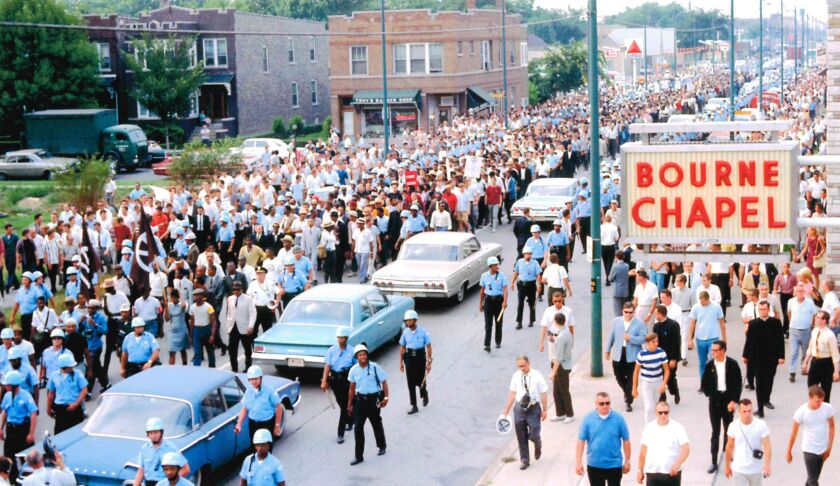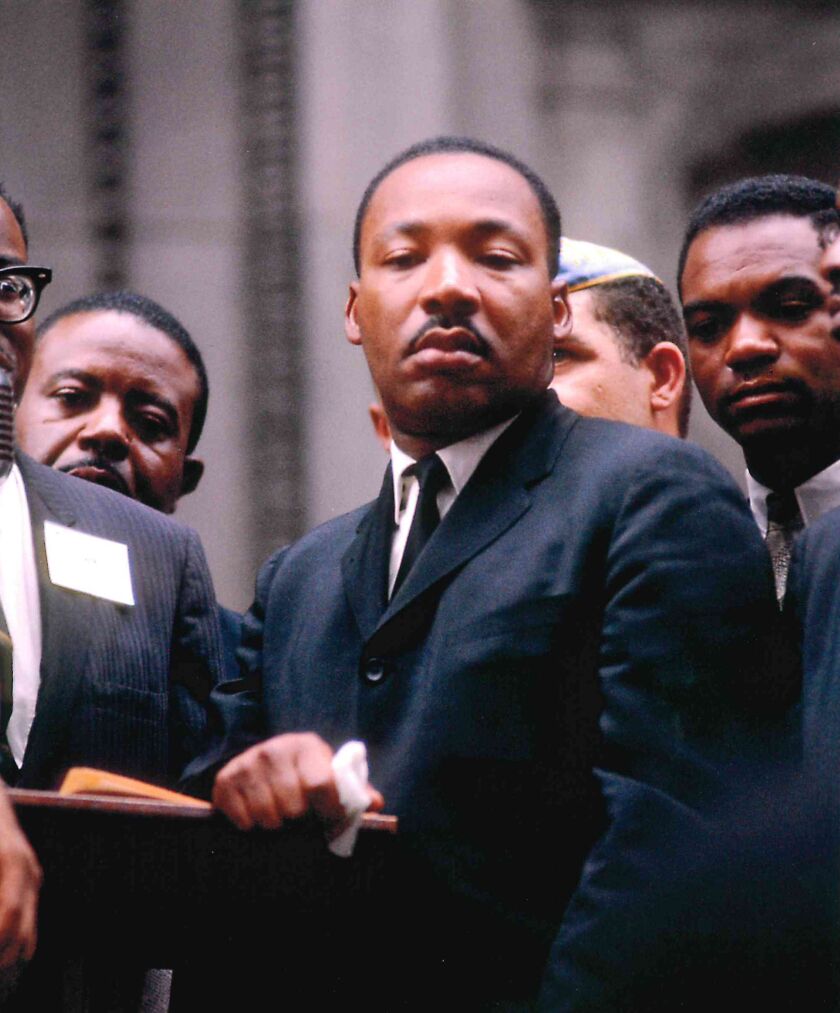It’s often been said that a picture is worth 1,000 words, “but I think it’s worth even more than that if a photographer is in the right place at the right time capturing something important,” says Wheaton resident Bernard Kleina, whose historic images are the centerpiece of a new exhibit at the Elmhurst Art Museum entitled “In Focus: The Chicago Freedom Movement and the Fight for Fair Housing.”
Running through June 20, the sprawling exhibit explores systemic issues of race-based discrimination surrounding housing opportunities in the Chicagoland area, combining a wealth of news articles, interviews and maps outlining the extraordinary inequities, along with 40 of Kleina’s photographs and first-hand accounts of the groundbreaking work of the Chicago Freedom Movement (CFM). Organized by Martin Luther King Jr., James Bevel and Al Raby during 1965-67, CFM was essential to the passing of the Fair Housing Act of 1968, which prohibited discrimination for housing rentals and loans based on race, religion, gender or national origin.
An amateur photographer at the time with an interest in social justice, Kleina was present to capture many of King’s movements after the civil rights icon moved his family into a modest Lawndale home to explore the issues of blockbusting and contract disparities happening around the city. Kleina’s images are some of the only full-color representations of King at the time, capturing him speaking at City Hall in July 1965, a Chicago Freedom Movement rally for open housing at Soldier Field in July 1966, and the violent clashes during a demonstration at Marquette Park that August.

This photo of Elmhurst in the mid-20th century is one of the many images featured in “In Focus: The Chicago Freedom Movement and the Fight for Fair Housing” at the Elmhurst Art Museum. In the 1960 census, 36,991 people called Elmhurst home; only 63 of them were identified as non-white.
Courtesy Elmhurst Art Museum Staff
“Before I photographed Dr. King, the only photos I ever took were family or vacations. That’s why I photographed in color. It didn’t even occur to me to shoot in black and white like everyone else was doing for newspapers and magazines,” recalls Kleina.
In fact, at the time he was a Catholic priest and Dean of Boys at Immaculate Conception High School just across the street from the Elmhurst Art Museum where his photos are now on display. Kleina first got involved with the civil rights movement after watching TV news footage of the now infamous events of the Bloody Sunday in March 1965 and heeding King’s call for clergy to come to Selma; his photos of Lewis, Brown Chapel, the Edmund Pettus Bridge and more from that time are also included in the exhibit.
“When we got there, maybe it’s because I’m white, I thought that I could do something to help out. But I soon realized that Selma did so much more for me than I could do for Selma. It literally changed my whole life,” says Kleina who, shortly after King’s assassination in 1968, left the priesthood and spent the next four decades as executive director of the west suburban-based nonprofit HOPE Fair Housing Center. HOPE is also a sponsor of the “In Focus” exhibit and worked with Elmhurst Art Museum to meet the ultimate goal to “educate through art and architecture.”
“In looking at Bernie’s photos and understanding that the Chicago Freedom Movement was centered around housing, we thought this really is a broader view of how we can talk about architecture as a museum. We aren’t just talking about the architectural details of a single house but rather more important issues,” says the museum’s executive director, John McKinnon. “One of the great things is that we were able to work with HOPE to demonstrate this is not just an urban problem but it affects many families in neighborhoods in Illinois. And In this case photography became a great way to talk about historical events and show how much it even affected places like Elmhurst.”
Kleina says correctly documenting history was also his motivation in photographing the events of 1965-67 and King, whom he regrettably never got to meet.
“So many officials and media were blaming Dr. King for inciting violence, and I felt that someone had to document what was going on to dispel that kind of language.” It’s an important topic today too, “now that everyone has the responsibility of a camera,” says Kleina, giving praise to 17-year-old Darnella Frazier who, last May, captured the death of George Floyd on video and transformed the nation into action. “I do tell younger people especially not to wait until they think they are totally competent to do any kind of assignment because the moment may pass you by,” Kleina adds.
The Elmhurst Museum was also keen to incorporate current events and younger artists into the exhibit for greater context and to inspire action. Also on display are photographs of the summer 2020 protests taken by 21-year-old Chicago photographer Vashon Jordan Jr., as well as a collaborative project, “Depth of Field” from the Design Museum of Chicago, Elmhurst Art Museum’s Teen Council and York Community High School’s Black Student Union, with collages made by teens in response to quotes about fair housing from activists and leaders.
The museum’s adjoining McCormick House offers “There is Black Housing in the Future: Equitable Public Housing as Memorial,” an installation from activists Alisha Wormsley of Pittsburgh and Chicago-based Ayanah Moor. “In Focus” concludes with an action center with further resources to help create change (also available online at elmhurstartmuseum.org).
Kleina will give a free virtual artist talk at 9 a.m. Thursday via the museum’s website.
Selena Fragassi is a local freelance writer.









